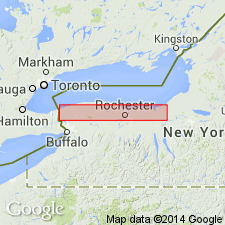
- Usage in publication:
-
- Brewer Dock limestones and shales
- Modifications:
-
- Named
- AAPG geologic province:
-
- Appalachian basin
Summary:
In the Clinton of Rochester region, above Maplewood shale is about 3 ft of interbedded limestone and shale, typically exposed in Genesee Gorge near Brewer Dock, and locally known as Brewer Dock limestone and shales. Characteristic fossil (chiefly in limestone layers) is a minute gastropod of genus CYCLORA. The brachiopod HYATTIDINA CONGESTA is also found in the formation. Underlies Furnaceville iron ore. Age is Silurian (Niagaran).
Source: GNU records (USGS DDS-6; Reston GNULEX).

- Usage in publication:
-
- Brewer Dock Member
- Modifications:
-
- Overview
- AAPG geologic province:
-
- Appalachian basin
Summary:
At Genesee Gorge in Rochester, where the Reynales Limestone is about 6.5 m thick, it is subdivided into (ascending) Brewer Dock Member and Wallington Member. The Brewer Dock is about 0.5 to 1.0 m thick and consists of light gray crinoidal- and bryozoan-rich limestone with considerable shale near the base. It includes the Budd Road Bed (new) at its base and the Seneca Park Bed (new) at the top. The Budd Road is a 1.0- to 6.0-cm thick silty limestone with very small phosphatic nodules and granules. Bed is traceable at least from Monroe Co to Niagara Gorge. The Seneca Park is a 20- to 40-cm thick hematitic fossil-rich limestone. Recent conodont investigation by Kleffner (1990, pers. commun) has revealed an abrupt change in assemblages within the Brewer Dock, occurring at the base of the Seneca Park Bed. It is Kleffner's interpretation that the interval above the base of the Seneca Park, including the remainder of the lower Clinton, is Llandoverian C-4 to C-5 in age and the interval below, including the Neahga and Maplewood Shales beneath the Brewer Dock is Llandoverian B to C-2. Authors disagree with this dating as there is no physical evidence for an unconformity below the Seneca Park, but suggest that an unconformity may exist below the Reynales Limestone and that the conodonts from the lower part of the Brewer Dock are actually reworked from the underlying strata.
Source: GNU records (USGS DDS-6; Reston GNULEX).
For more information, please contact Nancy Stamm, Geologic Names Committee Secretary.
Asterisk (*) indicates published by U.S. Geological Survey authors.
"No current usage" (†) implies that a name has been abandoned or has fallen into disuse. Former usage and, if known, replacement name given in parentheses ( ).
Slash (/) indicates name conflicts with nomenclatural guidelines (CSN, 1933; ACSN, 1961, 1970; NACSN, 1983, 2005, 2021). May be explained within brackets ([ ]).

